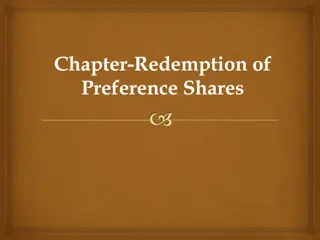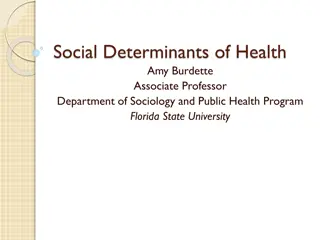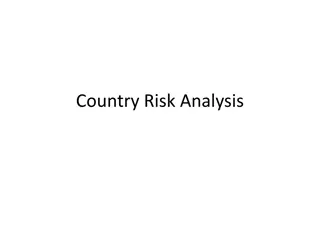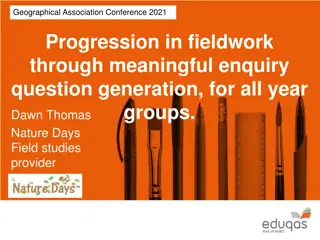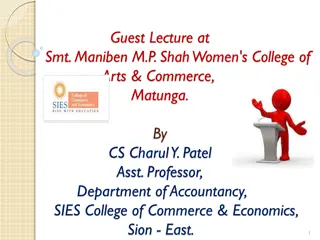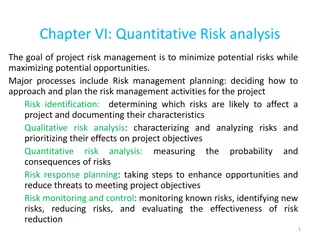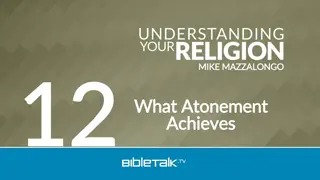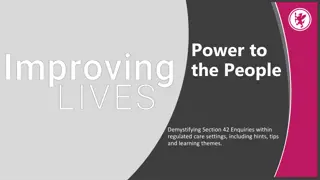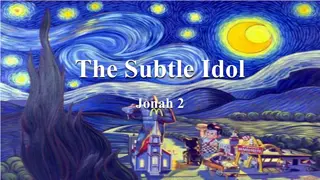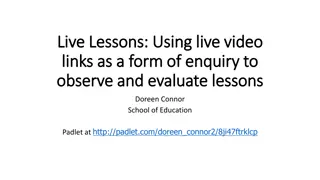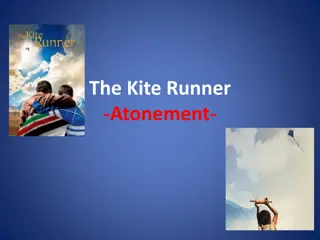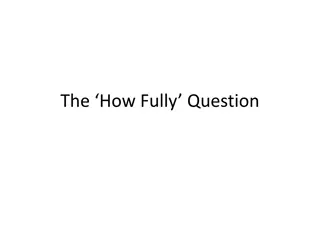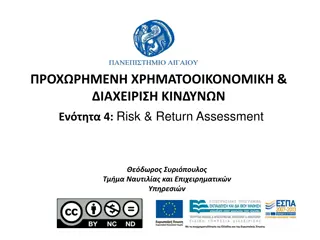Redemption and Risk: Social Enquiry and the New Penology
Social enquiry explores transitions from old to new penology, emphasizing risk management over treatment and responsibilization over mitigation. Probation officers act as storytellers shaping perceptions in the criminal justice system, prompting humane responses and social explanations. Research delves into the communication dynamics between report writers and sentencers in sheriff courts, highlighting the selection and delivery of messages. Regulation, reflexivity, and agency are crucial in understanding the role of report writers as marginal actors with influence.
Download Presentation

Please find below an Image/Link to download the presentation.
The content on the website is provided AS IS for your information and personal use only. It may not be sold, licensed, or shared on other websites without obtaining consent from the author.If you encounter any issues during the download, it is possible that the publisher has removed the file from their server.
You are allowed to download the files provided on this website for personal or commercial use, subject to the condition that they are used lawfully. All files are the property of their respective owners.
The content on the website is provided AS IS for your information and personal use only. It may not be sold, licensed, or shared on other websites without obtaining consent from the author.
E N D
Presentation Transcript
Redemption and Risk: Social enquiry and the new penology Fergus McNeill Glasgow School of Social Work Universities of Glasgow and Strathclyde Fergus.McNeill@strath.ac.uk Dr. Nicky Burns Law School University of Strathclyde Nicola.Burns@strath.ac.uk
Social enquiry and the new penology From old to new penology From welfare to risk From treatment to management From individuals to groups (dividuals) From mitigation to responsibilization From professionalism to managerialisation Evidence of transformation in the discourses, objectives and techniques of penality (Feeley and Simon 1992) Social enquiry: separating the incorrigible from the reclaimable ? Discourses of selection and suitability Rationales for leniency and for punishment (by de- selection) 2
Harris (1996) in their observational, reporting, recording and interventive activities probation officers are story-tellers par excellence, offering up for the consumption of other professionals not the truth tout court but a rendition of it which will be comprehensible and acceptable both in the language of their own invisible trade (Pithouse, 1987) and in that of their intended audience. But probation officers are not mere narrators standing aloof from the action, commenting, interpreting and advising in dispassionate terms. On the contrary, their narratives have about them a tactical aesthetic designed to promote a humane response from their audience, and even to inculcate a set of socio-political ideas by insinuating speculative but plausible social explanations of a specific criminal act into a quasi-legal document. This is narrative as action indeed Probation is marginal as a profession and marginal to criminal justice, social work and both central and local government. It claims a libertarian and egalitarian value base but daily imposes control on its charges in particular by the suspensiveness of its power (p118) 3
Research question and methods Part of a larger multi-method study of social enquiry and sentencing in the sheriff courts What does the contemporary report writer try to communicate to the sentencer, why are these particular messages selected and how are they communicated? Research sites and participants A qualitative approach: participant observation Fieldwork diary Observing cases Shadow writing Post-observation interviews 4
Regulation, reflexivity and agency Surround, field and frame (Hawkins, 2002) A fourth level: form The operationalisation of frame in a given case or situation: practice Report writers as marginal actors in the field Surviving the margins and constructing influence Reflexivity and agency Acquiring and employing capital in the field of criminal justice 5
Creating the narratives: constructing and revising Authorship Redrafting earlier authors versions Social worker, offender, and other voices SW-led, shared and contested authorship Coherence Consonance and dissonance within the new narrative Communication Persuasive and ambivalent Competing discourses? Selection: seriousness and suitability Technical and/or moral grounds for selection Redemption scripts and (implicit) condemnation scripts (Maruna 2001) 6
Constructing Geena and Patrick Geena Social worker and practice teacher Qualified for more than five years, specialist in criminal justice social work An enthusiast, committed to effective practice; a moderniser? Patrick Male, early 20s, 40+ previous convictions, history of drug misuse, on remand for possession of class C drugs, theft and possession of an offensive weapon and now in breach of an existing probation order, of bail and of release licence 7
SER summary Current situation Partner and daughter Fraught relationship instability Disadvantage The area His history of loss Educational disruption His mother s withdrawal Patrick s victimisation Drugs History of use and of unsuccessful change efforts Problems accessing structured support Current honesty and motivation Offending Long history Drug-related Honesty, remorse and insight Weapon but no intent to harm Options Breaches of previous orders Need to tackle drugs issue to reduce re- offending Defer to allow him access to services, under threat of strict enforcement 8
Geenas Patrick? Authorship Geena drafts a narrative that Patrick confirms: For example: Geena tells Patrick that she will be saying to the sheriff that custody has not addressed his addiction problems and will suggest a 3 month deferment. Patrick nods, but says he is going to jail [Geena] says that what he needs is a good conversation with a drug counsellor , Patrick agrees (Diary: week 12). Coherence The story of Patrick: a consonant narrative of redeemability but with dissonant elements? 9
Redeeming Patrick For Geena, Patrick s drug use is the main issue for her, from which his offending stems. Geena is trying to tell the sheriff that he is motivated and by noting his honesty in telling her about drugs, she is trying to show that he wants help. (Fieldwork diary week 12, p.20) Mr Swan was open and honest about his drug use and at our last probation meeting expressed a willingness to engage with the addiction services. However, he was incarcerated before he had the opportunity to speak to a trained drug counsellor (SER Case 19, p.4) According to Mr Swan his offending behaviour has mainly been influenced by his drug dependency problems. With regards to the offences before the court, Mr Swan has accepted all responsibility for all charges. He frankly admits that he offended on the [date] by stealing a quantity of personal goods for financial gain. Mr Swan was able to demonstrate a degree of regret and remorse for the offence committed. He was able to understand the direct correlation between his drug dependency and his offending (SER Case 19) 10
Geenas Patrick (contd.) Communication Persuasive consonance, but Dissonance lends credibility Her mentioning of the two probation orders shows that she is not daft and is being realistic with the court (Diary: week 12). Competing discourses? Technical and moral grounds for selecting Patrick Risk as a rationale for leniency It is the author s opinion that Mr Swan remains at high risk of re-offending if he does not address his addiction difficulties and breaks his cycle of offending behaviour (SER case 19). Redemption and/for risk reduction? 11
Tactics and strategies Geena on the margins of social work: survival and influence No, we don't have any direction, any influence, they [social work managers] are not interested in what we do and how, as long as we get reports to court So it's us and seniors, we really apart from us getting told off about something (Interview: Geena). Geena on the margins of criminal justice: survival and influence The writer has informed Mr Swan that she is prepared to work with him during probation, however, if he were to miss any appointments or fail to engage with the addiction services she would alert the court to this (Case 19: SER). Geena tells me that she is showing that she is accountable to the court and that she will do her job to ensure that Patrick complies (Diary: week 12). 12
Performing Geena Geena the moderniser: the what works agenda, discourses of risk and getting involved Geena goes on to note that many of the older staff members feel that what works is just another flavour of the month with [management], a way of seeing more clients in less time she however doesn t see it this way, it s about trying to improve service (Diary: week 1). Geena the traditional social worker Patrick states again that he is going to prison again and starts to cry. Geena tells him that all is not lost . Patrick shakes his head I always go back to smack : G: Why do you think you do that? P: Make me forget G: Is this a conscious decision you have made [to seek help]? P: Yes G: That s a really mature attitude to take (Week 12: 22/10/2003) 13
Discussion Preparing social enquiry reports is a kind of pre-sentencing focussed on selection The process is heavily regulated (structured) but is also (often) highly reflexive (agentic) SER authors often strive to construct consonant and persuasive narratives that provide moral and technical evidence of redeemability (rationales for leniency?); though they also sometimes condemn implicitly by failing to construct such accounts (dissonant and neutral narratives) Even the modernisers who best reflect and express the features of the new penology continue to trade in the discourses of the old; at the level of practice, the old and the new are blended together in attempts to construct influence (cultural capital?) in the field of criminal justice Welfare re-legitimated by risk The promise of effectively managed treatment Patrick as an individualised dividual Mitigation for and responsibilization of Patrick Geena as a managerialized professional 14
Conclusions Penal professionals are complex social actors The relationships between shifts in penal policies and shifts in penal practices are complex and contingent Changes in the surround and the field do not influence frames and forms in a linear fashion; forms of practice are both produced by and producers of frames, field and surround. Put another way, penal actors are not passive in the face of changes in the field and surround: they can respond with enthusiasm, compliance, resistance and/or subversion; their strategies can be conscious and reflexive (see also Robinson and McNeill 2004) Frames and forms needs to be explored ethnographically in order to understand the inter-relationships between form, frame, field and surround for different penal actors. This kind of enquiry seems best suited to revealing how penality is culturally produced and re-produced in practice A better understanding of these processes of production and reproduction is a pre-requisite of effecting change in penal systems 15
References Feeley, M. and Simon, J. (1992) The new penology: notes on the emerging strategy of corrections and its implications , Criminology 30: 449-474. Harris, R. (1996) Telling tales: probation in the contemporary social formation , in Parton, N. (ed.) Social Theory, Social Change and Social Work. London: Routledge. Hawkins, K. (2002) Law as Last Resort: Prosecution Decision- Making in a Regulatory Agency. Oxford: Oxford University Press. Maruna, S. (2001) Making Good. Washington: American Psychological Association. Pithouse, A. (1987) Social Work: the Social Organisation of an Invisible Trade. Aldershot: Gower Press. Robinson, G. and McNeill, F. (2004) Purposes Matter: The Ends of Probation in Mair, G. (ed.), What Matters in Probation Work. Cullompton: Willan. 16
Justifying assistance, in the public interest Sh 8: I looked at it from the point of view of dealing with a [man in his early twenties] with an absolutely horrendous record, serious problems, not much in not much positive to be said and yet the emphasis in the report appeared to be for some form of probation and assistance. Assistance is all very well if he's at an age, stage and position where he can take advantage of it but it doesn't appear to me from reading this report that this man was anywhere in the realms of getting that sort of disposal in the public interest. Maybe in his interest but it doesn't appear to be in the wider public interest that would be a likely outcome. 17
Hope and hopelessness Sh 10: I look first of all at the complaint and then look at the previous convictions. What this would tell me is that the accused is looking at a maximum custodial sentence but that he is such a bad offender where custody has had no possible benefit and is unlikely to be of any benefit other than keeping him away for a short period, that I may well be looking at the social enquiry report to see if there are any realistic reasons or proposals for a sentence other than a maximum custodial sentence... it is looking for hope in a hopeless situation. That's the approach I come to - 18
Patrick: Bad and hopeless Sh 9: Is there any good reason for deflecting this man from custody? Intv: And is there? Sh 9: I don't think so, no. Sh 8: Not reading the report, no. Sh 9: He's a very, very bad offender he's only [in his early twenties] and he's got a terrible record. Intv: I mean how would you characterise this guy? Sh 9: A hopeless case, to be honest. Intv: That's something else I was going to ask you, whether you thought there was any hope here. Sh 9: I think he is no, it doesn't look like it. Sh 8: He appears to be in the throes of a dreadful addiction to drugs and unable to sustain any assistance of any sort from anybody to try and deal with it in any united way for any length of time because his record shows he's just constantly in trouble. 19
Managing sentencing? Intv: And you think the social worker should play a part in managing acceptance of the sentence? Sh 10: I don't think the social worker no, I don't think the social worker should be saying as the defence agent will Look, with this record you're facing a maximum sentence, I will try to persuade the court A, B, C but I have to tell you and you will know you're facing a maximum sentence and you're lucky not to be on indictment. Now, she has upset the system by associating herself too closely with the accused, I think. Sh 9: Yes. Sh 8: Uh-huh, it's quite clear Sh 10: I haven't seen that phraseology before. Sh 8: No I haven't either but it's clear from reading the last two paragraphs that the author of this report thinks that this person should be placed on probation again and that she will support him in endeavouring to achieve a successful outcome on a probation order which, as history tells us, is extremely unlikely at this stage. And I think it takes away from the independence of the report. Sh 9: Uh-huh, yeah, absolutely. 20



